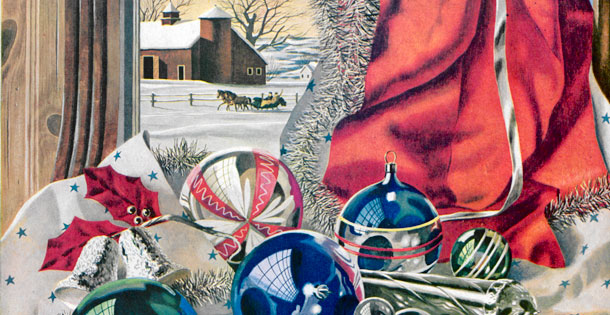
The Saturday Evening Post
John Atherton
December 18, 1943
Just about every American knows the words to the holiday tune popularized during World War II. But when the song “White Christmas” was composed, Irving Berlin had no idea it would be such a huge hit. Below is a 1951 article from the SEP archive, in which the famous composer reveals the secret behind the success of “White Christmas”:
Sure Sign That Christmas Is Coming
The Saturday Evening Post, November 17, 1951
By Robert M. Yoder
In 1939, Irving Berlin completed a sheaf of songs for a movie to be called Holiday Inn and looked them over with an expert eye. Along with being a composer and the greatest source of musical accompaniment for America’s festive occasions, Berlin is a publisher. It’s his business to know how a song will go. Only two of these looked hopeful. In Berlin’s estimation, “Be Careful, It’s My Heart” had a chance of becoming a hit. He expected a modest success, but no more, for a song called “I’m Dreaming of a White Christmas.”
Berlin has seldom been fooled by songs. This one fooled him completely. Of all his music — gay, sentimental or patriotic — it became “definitely the most successful,” he says. That means topping such stand-bys as “God Bless America,” which has earned well over $100,000 for the Boy Scouts and Girl Scouts, to whom Berlin assigned the royalties. “White Christmas” outsells even it.
What Berlin created, without in the least suspecting it, was a musical composition akin to Old Faithful, the geyser. It’s a rare song hit that survives the brief, intense popularity of its first success and becomes a “standard,” played year in and year out. White Christmas enjoys the rarest status of all — that of a perennial, automatic, ever-successful hit.
Every October for 10 years now, as surely as the leaves begin to fall, it begins to sell anew like a fresh hit. In a day when sheet-music sales of 300,000 are considered very good, it runs to well over 3 zmillion copies. “It’s a publishing business in itself,” Berlin remarks, meaning that one such song alone would keep a publisher happy.
The radio stations start playing it on Thanksgiving Day — in very cautious amounts, actually, compared to the repetition of jukeboxes. From Thanksgiving until midnight Christmas Day, there isn’t a minute when the song isn’t in the air somewhere. It is far more widespread than snow. In Vermont, a Christmas program would sound vaguely unofficial without it, though there may be 8 inches of cold reality outside to make this dream a little unnecessary. But they sing it just as often in Louisiana and Florida and tropical places never touched by a snowflake.
Played “to death” in 1942, the year the song appeared, “White Christmas” has been played to death every year since, but doesn’t die. For somewhere along the line it underwent a subtle transformation: It became a custom. A Gallup poll showed that of all the traditional Christmas music, only the classic “Silent Night, Holy Night” is a greater favorite. “Jingle Bells” and a dozen famous carols and hymns had to yield to Berlin’s wistful air.
“The proof that I didn’t expect this,” the composer says, “is in the verse.” For this is not, as thousands suppose, the expression of an American soldier honing for Christmas at home. According to the verse, it is the lament of a Northerner stuck in California, and beefing about spending Christmas under the palms. When it was written, anyone with the price of a railroad ticket or a few gallons of gasoline could easily attain a White Christmas. But by the time the song appeared in 1942, millions of Americans were overseas. So it came to represent the longing for an old-fashioned Christmas in a world at peace.
A seasonal, topical song is born with two strikes on it. Christmas, furthermore, is perhaps the single occasion with which popular-song writers have had the least luck. Why should this prove such a resounding exception? Berlin explains its success by saying he had thousands of collaborators. “People read a lot of things into that song,” he remarks, “that I didn’t put there.”
Become a Saturday Evening Post member and enjoy unlimited access. Subscribe now


